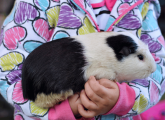Current affairs can inspire learning in all areas of your setting, say Lisa Lodge and Katie Naughton…
What springs to mind when you think about current affairs? 10pm news broadcasts, shocking headlines, politics, world problems? How can this possibly be suitable for children, especially the youngest in school?
In today’s digital world, the news travels fast – it’s accessible to everyone, including young children. They’re inevitably exposed to what’s happening around the globe, whether via overhearing adult conversations, encountering snippets from TV and radio, or through conversations with peers in the playground.
Accessing fragmented details like this may lead to children receiving inaccurate or inappropriate information, often beyond their understanding.
This can promote a range of emotional responses. Information from the news can unnerve, worry or scare children.
As teachers, we can practise techniques to acknowledge and deal with current affairs appropriately – this doesn’t need to be off-limits in the early years.
We’re often unaware of just how much early years pupils know about the news. An important first step of productive real-world learning is teaching children to ask questions about information they’ve encountered – whether it concerns or interests them.
Providing opportunities for children to do this in a safe environment with trusted adults strengthens teacher-pupil relations.
In an effort to promote transparency, this practice shows children that, even from a young age, they can ask anything, they will be listened to, and their questions will be answered.
As teachers, we can prioritise honesty while weighing up the level of detail to share, considering children’s age and developmental stage.
Providing reassurance is key, but shying away from important, real-world conversations can be damaging. Open and measured discussions can provide clarity and relief and prevent young children bottling up worries about what’s happening in the world.
Instead of waiting for children to divulge snippets of news they’ve heard, we can actively introduce current affairs into the classroom.
Thinking about the needs and interests of your group, select stories that will inspire and facilitate learning opportunities.
News can be anything happening in the world now, whether local or global. Whatever your focus, stories allow early years children to find out more about themselves, invigorate existing interests, or spark new ones.
Imagine the impact a story about a shipwreck discovery could have on a child who loves boats. Or what about a child who constantly talks about animals finding out about endangered wildlife in the news?
So you’ve found a news story you want to share. Now what?
Try teaching with images from the news. Acting as stimuli for speaking and listening practice, pictures encourage children to talk about what they can see, what they like or dislike, and what they think is happening.
A child can identify something they relate to. This creates further opportunities to practise sharing knowledge or experiences with others. It also allows us as adults to discover more about them.
Inspired by news-based visuals, children can develop early literacy skills, such as speaking in sentences, actively listening, and taking turns in conversations.
Simply allowing children to talk freely about their own lives or thoughts helps conversations flow and feel easier and relevant to them.
Some love sharing their knowledge and ideas, while some speak up because they care about a topic.
Of course, with exposure to varied news stories and related discussion, children naturally encounter new words, enhancing spoken vocabulary.
Hearing new words when learning about a news story provides opportunities to discuss what words mean, and connect them to real-life contexts.
After inspiring conversations, children often lead their own play based on the story’s theme. Or if they are not quite there yet, adults can set challenges.
A story about a space mission could perhaps encourage children to take on the roles of astronauts blasting off into space, or a story about a sportsperson may prompt children to try out the sport for themselves.
Adults facilitating this play can model using newly introduced words, deepening children’s understanding and embedding new terms into their everyday vocabulary.
News topics can inspire all areas of your setting. Every early years practitioner loves to see children motivated to mark make and write. When children are inspired about something that is happening right now, there are chances to write for real purposes.
It could be that, upon hearing about someone challenging themselves to visit every country without using a plane, children think about their own adventures and write a list of what to pack for their travels.
Or, a news story about a theme park opening might inspire children to draw and label their ideas about what the park should include.
Doing so can give meaning to writing practice, supporting children to put pencil to paper, mark make, and explain their work.
Embedding current affairs exploration encourages young children to talk about how topics make them feel. This therefore supports emotional literacy development.
Expressing feelings with peers in a safe space demonstrates a spectrum of responses. It shows we each respond differently to news and events, which is something children can learn to respect.
Deciphering responses to the news helps children relate feelings to emotional vocabulary, laying foundations to recognise, identify and express feelings.
This can help you broaden children’s vocabulary, from simply using “happy” and “sad” to advancing to more complex words, such as “angry”, “confused”, “excited”, “worried”, and “surprised”. This all contributes to exercising empathy.
Exploring topical themes both supports each child’s understanding of their own lives and experiences and enhances learning about the lives of others. It builds cultural capital.
Looking at real depictions of people and groups enables children to observe how their situations can be similar to or different from others’.
With real-life context from the news, children can learn about and respect diversity, including families, cultures, and religions.
Highlighting variety in this way helps shape children into empathetic, open-minded citizens, embedding positive attributes.
Bringing these learning objectives to life through a current affairs lens supports children to learn about the world in real time and keeps their education engaging.
Ultimately, for all of us, our key focus rests on helping children understand and discover the world, give purpose to learning and support their development, ready to move through school.
And if we can achieve this through fresh, topical focuses, then our children’s progression will be better for it.
Cover a range of stories: Sometimes you can be surprised by which stories inspire children the most.
Share child-friendly images: This starts conversations and allows children to make their own links to what they can see.
Make time to ask questions: Ensure details shared are accurate and age-appropriate, with opportunities to discuss what’s happening.
Explore topical themes: Whether it’s role play, writing for real purposes, or building in the construction area, let children lead. Their ideas are always the best!
Lisa Lodge is an Early Years consultant and Katie Naughton is an education content writer. Picture News Early Years is a weekly news resource supporting children’s understanding of the world around them. Every pack includes real-life images, open questions, provision area ideas, key vocabulary words, and more. To access a free resource to try with your class, email .(JavaScript must be enabled to view this email address) with the exclusive code TEACHEY.

Active learning in EYFS – How to encourage it
Editors picks

Pets in school – Does your setting need an animal?
Editors picks
